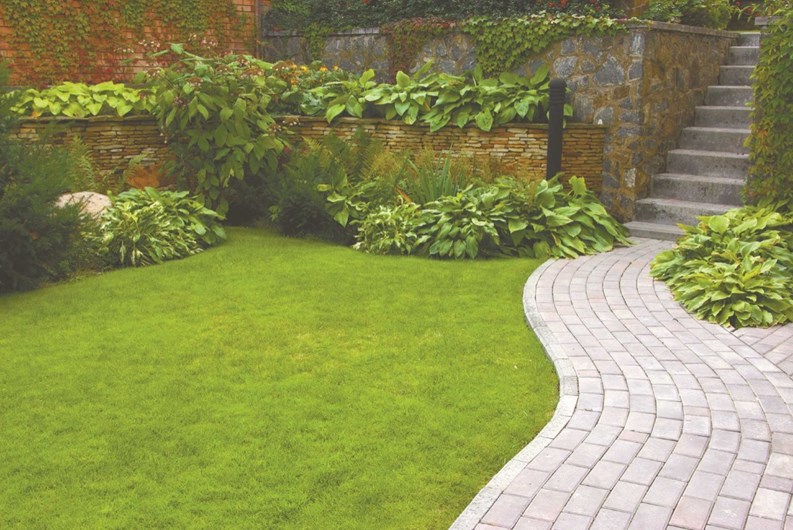The snow is finally starting to melt after what has seemed like an extra long winter. Of course, that means the grass is thankfully starting to peek through and reintroduce itself. And with this reintroduction comes a required spring cleanup because no element communicates an association’s commitment to good maintenance and upkeep quite like a lush, verdant lawn.
A beautiful lawn translates into better curb appeal and, hopefully, a higher resale value. And during this struggling economy and real estate market, sellers and associations can use all the help they can get to stand out in a positive light. But old man winter has really battered and beaten the lawn—leaving brown patches, bare earth and withered grass. On top of that, springtime also means the lawn will be prone to weeds and sun damage. It’s time to make sure the lawn is cared for and protected.
Seed vs. Sod
First, what’s on the ground—seed or sod? Most existing homes and associations in New Jersey have been seeded, while most newly constructed homes have been sodded.
“Sod is grass that has already been grown and then cut from the ground with soil and roots attached,” says Michael Almstead, manager of Almstead Tree & Shrub Care Company, LLC in Wyckoff, New Jersey. “The big strips of sod have been cared for by a professional. Builders usually do this so they have instant results and a beautiful lawn absolutely helps sell a house. The benefit of sod is that it’s quite easy to lay; even a large yard can be laid in a day.”
Almstead explains that sod is grown on local specialist farms to avoid long transport and drying out and heat buildup of the product.
“It is usually harvested 10 to 18 months after planting,” says Almstead. “On the farm it undergoes fertilization, frequent watering, frequent mowing and subsequent vacuuming to remove the clippings. It is harvested using specialized equipment, precision cut to standardized sizes. Sod is typically harvested in small square slabs, rolled rectangles, or large 4-foot wide rolls.”
Sod has several benefits. It can be laid in sloped areas and areas that are prone to erosion. It can also be laid at any time during growing season, so if your property is missing large patches of grass, laying down sod may be a good solution. Whether or not sod is used on a property comes down to cost. Sod is much more expensive than seeding and its choices of grasses are more limited. However, while seeding is more affordable, it’s more time and labor intensive while you wait for the grass to grow in.
“For best results, if you decide to seed, you are basically limited to (putting it down in) late summer and early fall,” says Almstead. “When deciding on your lawn, you also need to research the type of seed to plant that will thrive in the climate of your home.”
Once the initial sod is laid down and watered, there is no difference in care and can be subjected to the same wacky weeds and nuisance plants that seeded lawns can.
Wacky Weeds and Pesky Plants
A weed is any plant that is a nuisance to the homeowner. It could be that the plant is unsightly, hard to remove, or just growing in the wrong area. Other weeds can actually cause more damage because they prevent light and nutrients getting to the wanted fauna or they can grow and multiply at such a rapid rate they are hard to control.
So, for example, if you’re planting a garden of roses and up pops a dandelion, that’s considered a weed. But a dandelion growing in a field of dandelions, or on a property where the dandelions are wanted, is not considered a weed. Unfortunately, the poor dandelion—the yellow flower that turns white and kids enjoy making wishes on and blowing into the wind—has gotten a bad reputation among gardeners. It was cited as one of the most common weeds in New Jersey by the experts interviewed for this article. Other plants and grasses that made the weed list were clover, Japanese stilt grass, yellow nutsedge and crabgrass.
Crabgrass is a grass that roots deeply and grows wildly within the grass. “Each weed creates its own nuisance and crabgrass is a warm season grass, which allows it to thrive in hot and humid temperatures when cool season grasses are weak and/or dormant,” says Chris Charnesky, owner of Vasile Green Landscaping in Wyckoff, New Jersey. “Some weeds can be controlled with broadleaf weed controls where as others, such as crabgrass, have to be controlled with a pre-emergent,” he says.
A pre-emergent is a preventative measure that tries to stop the weed from growing before it even starts.
“It is crucial to put down a pre-emergent annually especially when the lawn has had crabgrass previously, in order to control and eradicate it,” says Charnesky. “In the spring the plant will not be present because it is an annual. It seeds itself at the end of the season so it becomes a silent killer as the season moves forward and will reappear come the summer months if a pre-emergent is not used. “
Dandelions can be controlled by mowing frequently to prevent the flower from maturing. But if children are already making wishes on them and the white fuzzy tops are blowing in the wind, your problem just got bigger. Other methods, such as fertilizing, pulling weeds down to the root, applying herbicides—which are safer for your grass—and aerating (creating air spaces in the grass) can also help reduce the weed population in the yard.
“Aeration helps to avoid soil compaction and creates a better environment for turfgrass roots,” says Charnesky. “It also helps to maintain proper permeability, resulting in better soil conditions and less chance of developing turf diseases. Fertilizers can be very helpful when used properly. The danger to pets and children vary from product to product but when used properly can be very safe. If you’re willing to pay the extra bucks to use an organic program that is the safest bet, but again that is personal preference.”
Weeds aren’t just an annoyance to the homeowner or maintenance person, they are also a signal that something else may be going on underground.
“If weeds are taking over your lawn, this is a sign there’s either a soil problem or a light problem,” says Charnesky. “Have nutrients been applied to the lawn on a regular basis? Is the soil compacted? Is there a too thick layer of thatch? Is the soil dried out from lack of water? These are all problems that can cause a lawn to thin out and provide an opening for weeds to grow. Often problems result from multiple sources. For example, a lawn that isn’t fertilized properly and probably isn’t being aerated regularly. “
Main Threats
Once the weeds are under control, you might think it’s safe to step back outside and enjoy the lawn, but wait! It may have other potentially harmful threats with the soil and insects and disease, oh my!
“Anything but green and lush is a sign of a problem,” says Michael Cioffi, sales and services manager for Borst Landscape & Design in Allendale, New Jersey, who suggests a soil test to determine what soil problems already exist. “Rutgers or your local agricultural extension program can give you the name of a lab for the soil test.”
The test will provide you with detailed information about the nutrients that are found in the soil as well as any potential contaminants. With this information in hand, you or your landscape professional can devise a plan of action to tackle problems and improve the landscape.
Taking Care of Business
Just remember however, that taking care of a landscape isn’t just about watering the lawn. As a matter of fact, most people don’t even know how to do that correctly—either too much or too little.
“Common mistakes when taking care of the lawn include over watering, cutting grass too short and improper applications of fertilizers and/or pesticides,” says Cioffi.
“They don’t realize that this is a living organism/eco-system. It needs to be treated as such,” says Kukol. “I often tell people that new grass is like an infant—frequent watering and feeding and treat tenderly. They think that it’s just a carpet they can treat like a doormat and then wonder why it struggles.”
“A watering schedule is recommended for homeowners who would like to maintain a healthy lawn,” says Almstead. “Watering amounts will depend on the seasonal changes, the weather and climate, and the area. Generally, the best time to water your lawn would be early in the morning, when you will have the least amount of evaporation. Timing and scheduling also applies to fertilizing you lawn. Depending on your location, fertilization of the lawn varies.
Calling in the Professionals
However, if the lawn has serious problems or needs more qualified attention, perhaps it’s time to put it in the hands of a specialist. “Properly caring for a lawn can be a time staking daily activity that some people simply lack the interest for upholding,” says Almstead. “Most lawns require frequent weeding, mowing, and watering plus annual regiments such as fertilizing, aerating, or thatching.”
Charnesky says if you don’t know what you are looking at, call a pro. “Pay the consulting fee to get their advice and then decide if you want to tackle the rehabilitation task yourself or hire a green industry professional for the job,” he says.
Look for a lawn care specialist who has passed qualifying examinations, is licensed and has on-the-job experience.
“Some have gone to school and majored in turf-grass management, horticulture or landscape design and other professionals have learned from their superiors before branching off on their own.,” says Charnesky. “The state requires anyone that applies pesticides to be licensed.”
Having a beautiful lawn comes down to what you put into it, and by that, we don’t mean chemicals. It takes time, patience and a basic understanding of potential problems and how to fix them. By regularly maintaining your lawn, you’ll be reaping the benefits of a well-kept landscape each and every year.
Lisa Iannucci is a freelance writer and a frequent contributor toThe New Jersey Cooperator.







Leave a Comment